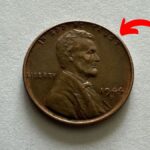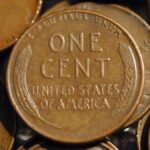The Lincoln Wheat Penny Valued at $170 Million: The world of coin collecting holds many fascinating stories, but few are as captivating as that of the Lincoln Wheat Penny. While most people might overlook these copper coins in their spare change, certain rare specimens have achieved astronomical values, with some worth up to $170 million. This remarkable story of numismatic treasure continues to inspire collectors and history enthusiasts alike.
Historical Background
The Lincoln Wheat Penny made its debut in 1909, marking a significant milestone in American coinage as the first U.S. coin to feature a president’s portrait. Designed by Victor David Brenner to commemorate the centennial of Abraham Lincoln’s birth, the coin showcases Lincoln’s profile on the front and two wheat stalks on the reverse, symbolizing America’s agricultural heritage. This design remained in production until 1958, when it was replaced by the Lincoln Memorial design.
The Million-Dollar Mystery
Among these pennies, the 1943 Copper Penny stands as the most valuable and sought-after variety. During World War II, the U.S. Mint switched to steel pennies to conserve copper for the war effort. However, a few copper blanks accidentally made their way into production, creating what would become one of the rarest coins in American history. With only 20 to 30 known examples, these pennies command extraordinary prices, with one specimen selling for $1.7 million at auction.
What Makes Them Valuable
The value of Lincoln Wheat Pennies is determined by several crucial factors. Minting errors, such as doubled dies or off-center strikes, can significantly increase a coin’s worth. The rarity factor, particularly for coins from specific years or mints, plays a vital role. Additionally, the historical context and the coin’s condition greatly influence its market value. Pristine, uncirculated specimens naturally command the highest prices.
Identifying Rare Specimens
For those hoping to discover a valuable Wheat Penny, certain characteristics deserve special attention. Key dates to look for include 1909-S VDB, 1914-D, and the famous 1943 copper specimens. The mint mark location can also indicate rarity, with San Francisco (S) and Denver (D) minted coins often being more valuable than their Philadelphia counterparts. Careful examination using a magnifying glass can reveal valuable minting errors or unique features.
The Thrill of the Hunt
What makes the Lincoln Wheat Penny particularly exciting is that valuable specimens might still be in circulation. While finding a rare example is uncommon, it’s not impossible. Collectors continue to discover valuable pennies in old collections, inherited coin jars, and occasionally even in everyday transactions. This possibility of finding treasure in ordinary places keeps the hobby exciting and accessible to everyone.
Historical Significance
Beyond their monetary value, Lincoln Wheat Pennies serve as tangible connections to American history. They witnessed the nation’s journey through the Great Depression, World War II, and the post-war economic boom. The 1943 copper specimens, in particular, tell a compelling story about wartime resource management and industrial adaptation.
Starting Your Collection
For aspiring collectors inspired by these million-dollar possibilities, beginning a collection requires careful preparation and knowledge. Essential tools include a quality magnifying glass for detailed examination and proper storage materials to preserve coins’ condition. Education about mint marks, grading standards, and historical context proves invaluable in identifying potentially valuable specimens.
Preservation and Care
Proper handling and storage are crucial for maintaining a coin’s value. Experts recommend handling coins by their edges and never cleaning them, as improper cleaning can significantly reduce their worth. Using appropriate storage materials and maintaining stable environmental conditions helps preserve coins for future generations.
Market Dynamics
The value of rare Lincoln Wheat Pennies continues to appreciate as collectors and investors recognize their historical significance and rarity. Market prices can fluctuate based on various factors, including condition, authenticity verification, and overall collector demand. Professional grading services play a crucial role in authenticating and valuing these prestigious coins.
Community and Education
The coin collecting community offers valuable resources for both novice and experienced collectors. Local coin clubs, online forums, and numismatic organizations provide opportunities to learn, share knowledge, and connect with fellow enthusiasts. These communities often serve as excellent sources for education about coin identification, preservation, and valuation.
Conclusion
The Lincoln Wheat Penny represents more than just a collectible coin; it embodies American history, craftsmanship, and the enduring appeal of numismatic treasure hunting. While finding a million-dollar specimen remains a rare occurrence, the possibility adds excitement to this engaging hobby. Whether valued at millions or just a few cents, each Wheat Penny tells a story of American heritage and the artistry of coin manufacturing. For collectors and history enthusiasts alike, these modest copper coins continue to fascinate and inspire, proving that sometimes the most valuable treasures come in the smallest packages.



